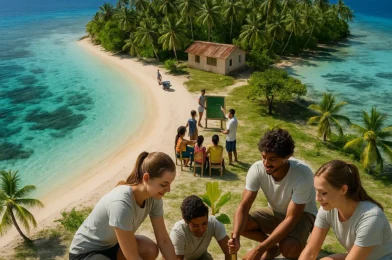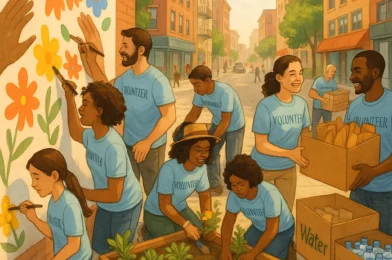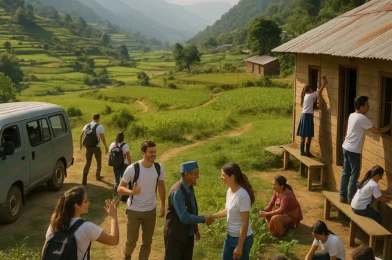There’s a map of the world you know well—a web of cities, highways, and Wi-Fi signals. But then there’s another map, one made of unpaved paths, winding rivers, and vast silences. It’s a map of places where the modern world’s frantic hum fades away, replaced by the sound of the wind or the calls of unseen wildlife. You feel a pull to this second map, a desire for an experience that is truly, profoundly authentic.
This is the world of off-the-grid volunteering. It’s a call to journey beyond the reach of cell towers and tourist trails, to serve in remote regions where the needs are often the greatest precisely because they are the hardest to reach. This is not about a rustic weekend getaway; it’s a deep dive into a life stripped down to its essentials.
This guide is for the resilient, adventurous soul who is ready for a real challenge. It’s for you if you understand that true impact often requires stepping far outside your comfort zone. We will explore what it really takes to serve in these environments and highlight four remote regions of the world where your helping hands are needed most.
The Reality Check: Are You Ready to Go Off the Grid?
Before you start dreaming of your destination, you must have an honest conversation with yourself. Volunteering in a remote location is not for everyone. It demands a high level of resilience, self-sufficiency, and humility.
- Physical Resilience: Are you in good physical health? Life off the grid often involves manual labor, long treks on foot, and exposure to harsh climates, whether it’s intense humidity in the jungle or biting cold in the mountains. You must be prepared for basic living conditions, a simple diet, and the absence of modern plumbing and electricity.
- Mental and Emotional Fortitude: This is perhaps the biggest challenge. Can you handle true isolation? You will be disconnected from your usual support network of friends and family. There will be no social media to scroll through when you’re bored or lonely. You need to be a creative problem-solver, comfortable with your own thoughts, and able to find joy and purpose without external validation.
- A True Servant’s Heart: This is not adventure tourism with a bit of volunteering tacked on. The work can be unglamorous, repetitive, and demanding. Your primary purpose is to serve the needs of the community as they have defined them. This requires immense patience, flexibility, and a willingness to put the needs of others far ahead of your own desire for an “adventure.”
If you read this and feel a sense of excitement rather than dread, then you may be ready for the unpaved path.
Four Remote Regions Calling for Your Help
These destinations offer some of the most challenging and rewarding volunteer opportunities on the planet, placing you right at the heart of critical conservation and community initiatives.
1. The Amazon Rainforest, Ecuador & Peru
The Amazon is the lungs of our planet, a vast, biodiverse wilderness that is critically threatened by deforestation and climate change. Deep within the rainforest, accessible only by boat, are indigenous communities who have stewarded this land for centuries, along with research stations working to protect it.
- The Off-the-Grid Reality: Expect to travel for days by river canoe to reach your project site. You’ll be living in a simple, open-air encampment with no electricity, no cell service, and only the sounds of the jungle at night.
- The Critical Need: The primary focus is conservation and supporting the indigenous communities whose way of life is under threat.
- Your Volunteer Role: Your work is hands-on and vital. You could be:
- Monitoring wildlife populations by checking camera traps and recording animal tracks.
- Participating in reforestation projects, planting native trees to restore degraded areas.
- Assisting researchers with biodiversity surveys and data collection.
- Working with indigenous communities on sustainable agriculture or eco-tourism projects.
- Your Impact: You are a direct contributor to the scientific research and conservation efforts that are essential for protecting the most biodiverse ecosystem on Earth.
2. Rural Madagascar
Often called the “eighth continent,” Madagascar is a world unto itself. Its long geographic isolation has resulted in thousands of species found nowhere else. In the remote, rural interior of the island, far from the few paved roads, are villages and forests that are home to this unique and endangered wildlife.
- The Off-the-Grid Reality: Reaching your project will involve long, rugged overland journeys. You’ll be living in a basic camp or a village homestay with limited access to running water and a diet of local staples like rice and beans.
- The Critical Need: Madagascar faces a severe deforestation crisis, which threatens its iconic wildlife, most notably its many species of lemurs.
- Your Volunteer Role: Your work is on the front lines of conservation and community support. You might be:
- Trekking into the forest to track and monitor lemur populations.
- Working in tree nurseries and participating in large-scale reforestation efforts.
- Teaching basic English and environmental education in a small village school.
- Assisting with community health initiatives in villages that have no other access to care.
- Your Impact: You are helping to protect some of the most unique and endangered species on the planet while supporting communities that live on the edge of these fragile habitats.
3. The Outer Islands of Fiji
While Fiji’s main islands are known for tourism, its hundreds of outer islands offer a glimpse into a more traditional and remote way of life. Many of these small islands are accessible only by infrequent ferries or small boats and have very limited infrastructure.
- The Off-the-Grid Reality: You’ll be living in a traditional Fijian village, likely in a homestay with a local family. Life is governed by the tides, the weather, and deep community bonds. Expect no Wi-Fi, limited electricity from a generator, and a diet of what is fished from the sea and grown in the village gardens.
- The Critical Need: Needs often focus on education, public health, and marine conservation to ensure the sustainability of the village’s primary food source.
- Your Volunteer Role: You will be fully integrated into village life. Your work could include:
- Assisting the sole teacher in a multi-grade village school.
- Helping to establish coral farms to regenerate local reefs damaged by storms.
- Running basic health and hygiene workshops for children and adults.
- Working on sustainable farming and clean water projects.
- Your Impact: You are providing vital support that directly improves the quality of life, education, and food security for an entire island community.
The Essential Gear and Mindset
- Pack for Self-Sufficiency: Your packing list is your lifeline. A high-quality headlamp (with extra batteries), a reliable water filter or purification tablets, a comprehensive personal first-aid kit, and a solar-powered charger for essential electronics are non-negotiable.
- Let Go of Control: In remote regions, plans are merely suggestions. A heavy rain could make a road impassable. A boat engine might fail. You must embrace uncertainty and be able to adapt with a positive attitude. Flexibility is not a suggestion; it’s a survival skill.
- Discover the Power of Presence: With no digital distractions, you will be left with the most powerful tool you have: your own undivided attention. Listen to the stories of the people you are with. Observe the intricate details of the natural world around you. This is your opportunity to connect on a truly human level.
Volunteering off the grid is one of the most demanding journeys you can choose, but it is also one of the most rewarding. It will challenge you, change you, and give you a powerful new perspective on the world and your place in it. It is a journey for the resilient, the humble, and the truly adventurous spirit who believes the most meaningful paths are often the ones that are unpaved.
What’s the most “off-the-grid” place you’ve ever been? Share your experience or what you learned about yourself in the comments below!





